warning lights CHEVROLET TRACKER 1998 1.G Owners Manual
[x] Cancel search | Manufacturer: CHEVROLET, Model Year: 1998, Model line: TRACKER, Model: CHEVROLET TRACKER 1998 1.GPages: 386, PDF Size: 21.17 MB
Page 6 of 386
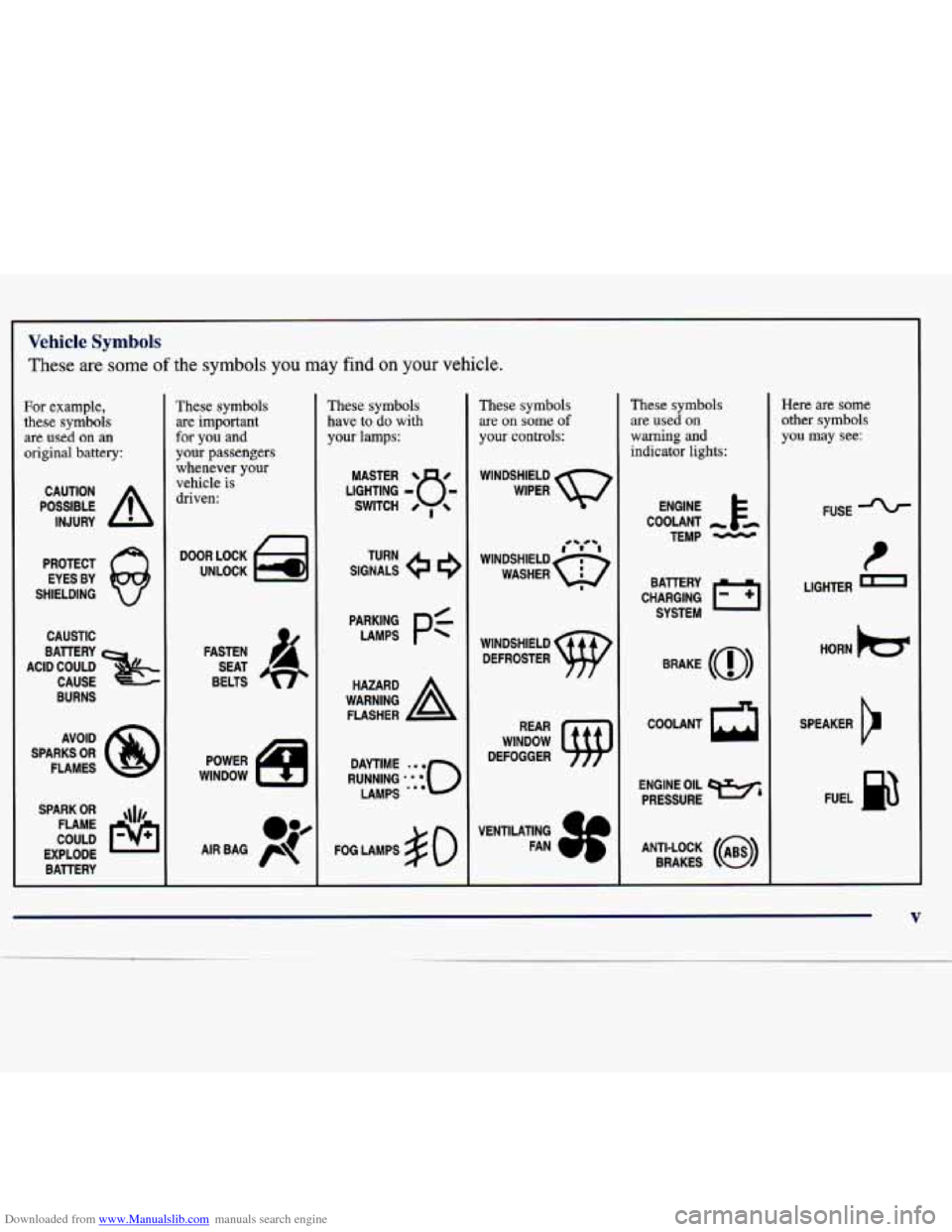
Downloaded from www.Manualslib.com manuals search engine L
Vehicle Symbols
These are some of the symbols you may find on your vehicle.
For example,
these symbols are used on
an
original battery:
POSSIBLE A
CAUTION
INJURY
PROTECT EYES BY
SHIELDING
CAUSTIC
BURNS
SPARK
OR ,111,
COULD FLAME
EXPLODE BATTERY
These symbols are important
for
you and
your passengers whenever your
vehicle
is
driven:
DOOR LOCK
UNLOCK
FASTEN SEAT
BELTS
These symbols
have
to do with
your lamps:
SIGNALS e
TURN
FOG LAMPS
$0
These symbols
are on some of
your controls:
WINDSHIELD WIPER
WINDSHIELD DEFROSTER
WINDOW
DEFOGGER
REAR
VENTILATING
FAN
These symbols
are used on
warning and
indicator lights:
COOLANT
TEMP
-
CHARGING I-1
BAlTERY
SYSTEM
BRAKE
(a)
ENGINE OIL e,
PRESSURE
ANTI-LOCK
(@)
BRAKES
Here are some
other symbols
you may see:
FUSE -%-
P
LIGHTER u
HORN )tr
SPEAKER
cz
FUEL B
V
Page 60 of 386
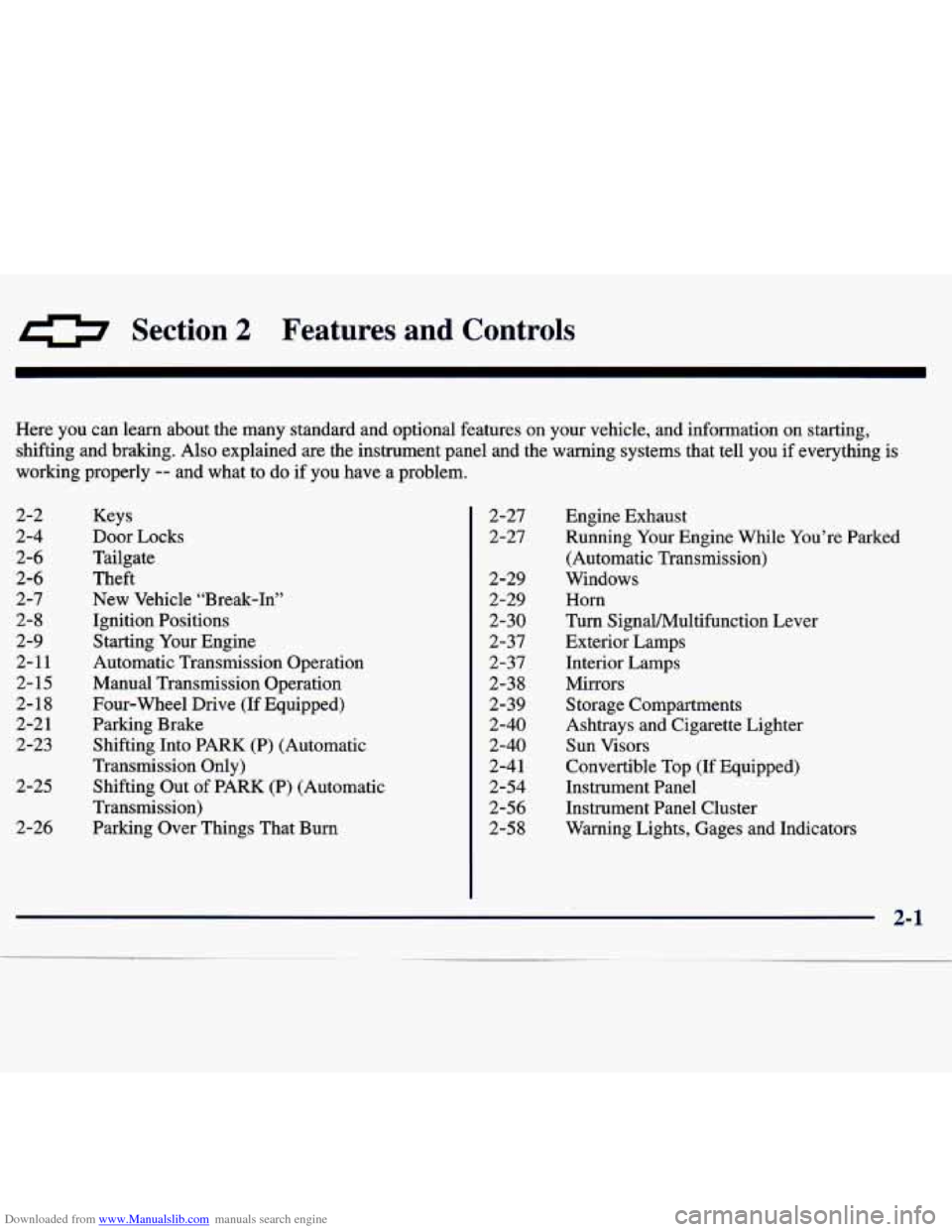
Downloaded from www.Manualslib.com manuals search engine e Section 2 Features and Controls
Here you can learn about the many standard and optional features on your vehicle, and information on starting,
shifting and braking. Also explained are the instrument panel a\
nd the warning systems that tell you if everything is
working properly
-- and what to do if you have a problem.
2-2
2-4
2-6 2-6
2-7
2-8
2-9
2-1
1
2- 15
2-18
2-2
1
2-23
2-25
2-26
Keys
Door Locks Tailgate
Theft
New Vehicle “Break-In”
Ignition Positions Starting Your Engine
Automatic Transmission Operation
Manual Transmission Operation
Four-wheel Drive (If Equipped)
Parking Brake
Shifting Into PARK (P) (Automatic
Transmission Only) Shifting Out
of PARK (P) (Automatic
Transmission)
Parking Over Things That Burn
2-27
2-27
2-29
2-29
2-30
2-37
2-37
2-38
2-39
2-40
2-40
2-4
1
2-54
2-56
2-58
Engine Exhaust
Running Your Engine While You’re Parked
(Automatic Transmission)
Windows
Horn
Turn SignaYMultifunction Lever
Exterior Lamps
Interior Lamps Mirrors Storage Compartments
Ashtrays and Cigarette Lighter
Sun Visors
Convertible Top (If Equipped)
Instrument Panel
Instrument Panel Cluster
Warning Lights, Gages and Indicators
Page 67 of 386
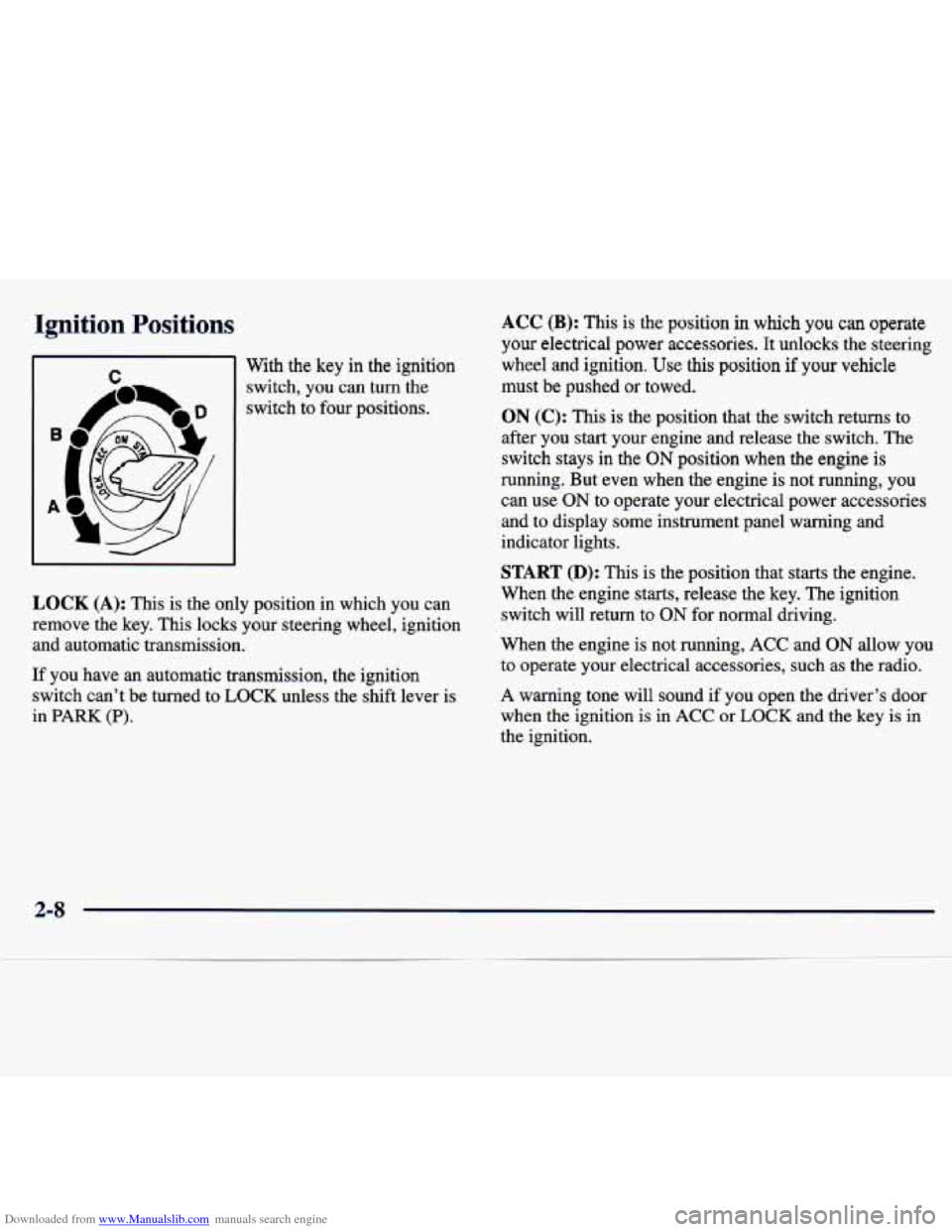
Downloaded from www.Manualslib.com manuals search engine Ignition Positions
m I With the key in the ignition
rr
4 I
switch, you can turn the
switch to four positions.
LOCK (A): This is the only position in which you can
remove the key. This locks your steering wheel, ignition and automatic transmission.
If you have
an automatic transmission, the ignition
switch can’t be turned to
LOCK unless the shift lever is
in
PARK (P).
ACC (B): This is the position in which you can operate
your electrical power accessories. It unlocks the steering
wheel and ignition. Use this position
if your vehicle
must be pushed or towed.
ON (C): This is the position that the switch returns to
after you start your engine and release the switch. The
switch stays in the
ON position when the engine is
running. But even when
the engine is not running, you
can use
ON to operate your electrical power accessories
and
to display some instrument panel warning and
indicator lights.
START (D): This is the position that starts the engine.
When the engine starts, release the key. The ignition
switch will return to
ON for normal driving.
When the engine is not running,
ACC and ON allow you
to operate your electrical accessories, such as the radio.
A warning tone will sound if you open the driver’s door
when the ignition is in
ACC or LOCK and the key is in
the ignition.
2-8
Page 117 of 386
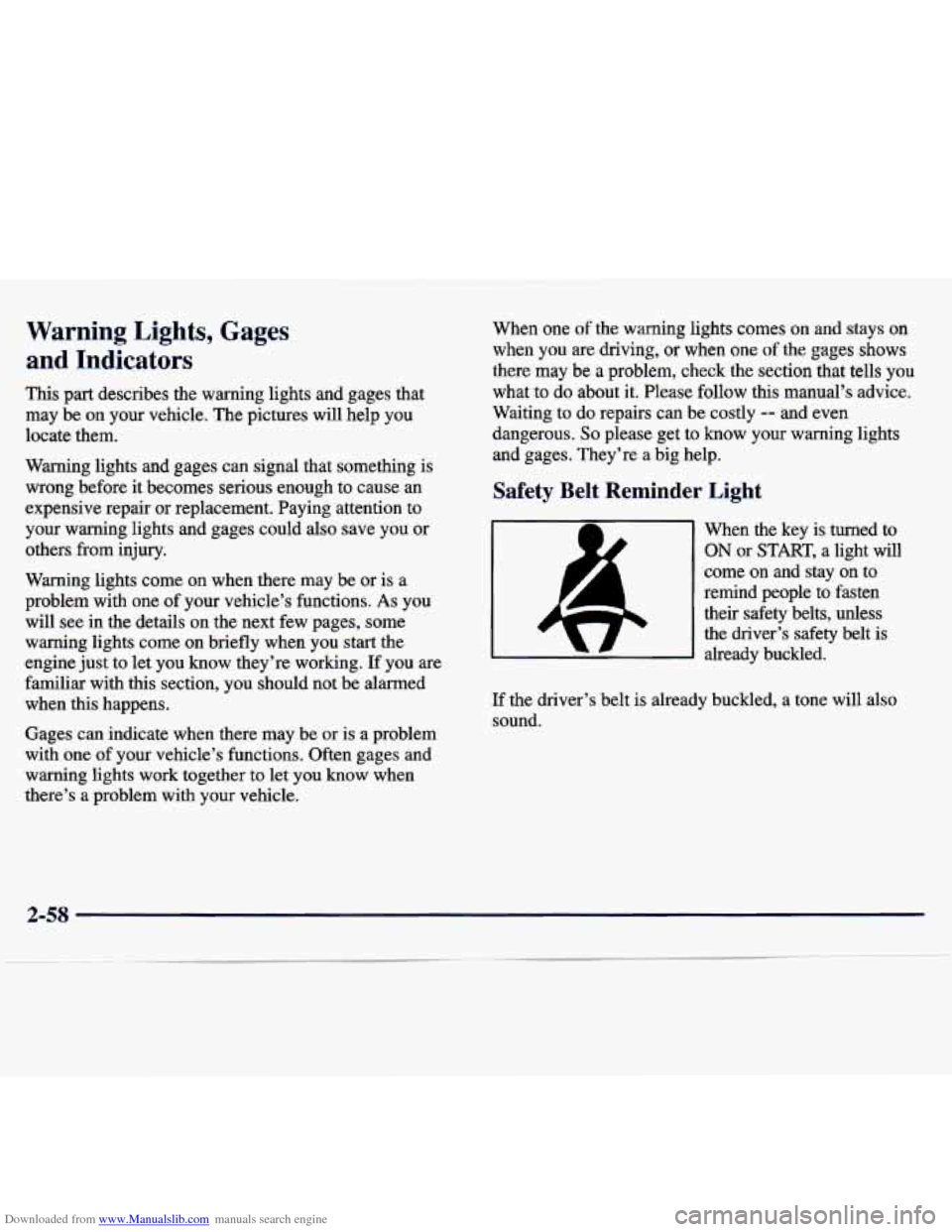
Downloaded from www.Manualslib.com manuals search engine Warning Lights, Gages
and Indicators
This part describes the warning lights and gages that may be on your vehicle. The pictures will help
you
locate them.
Warning lights and gages can signal that something is
wrong before it becomes serious enough to cause an
expensive repair or replacement. Paying attention to
your warning lights and gages could also save you or
others from injury.
Warning lights come on when there may be or is a
problem with one of your vehicle’s functions.
As you
will see in the details on the next few pages, some
warning lights come on briefly when you start the
engine just to let you know they’re working. If you are
familiar with this section, you should not be alarmed
when this happens.
Gages can indicate when there may be or is a problem
with one of your vehicle’s functions. Often gages and
warning lights work together to let you
know when
there’s
a problem with your vehicle.
When one of the warning lights comes on and stays on
when you
are driving, or when one of the gages shows
there may be a problem, check the section that tells you
what to do about
it. Please follow this manual’s advice.
Waiting to do repairs can be costly
-- and even
dangerous.
So please get to know your warning lights
and gages. They’re a big help.
Safety Belt Reminder Light
When the key is turned to
ON or START, a light will
come on and stay on to
remind people to fasten
their safety belts, unless
the driver’s safety belt is
already buckled.
If the driver’s belt is already buckled, a tone will also
sound.
2-58
Page 261 of 386
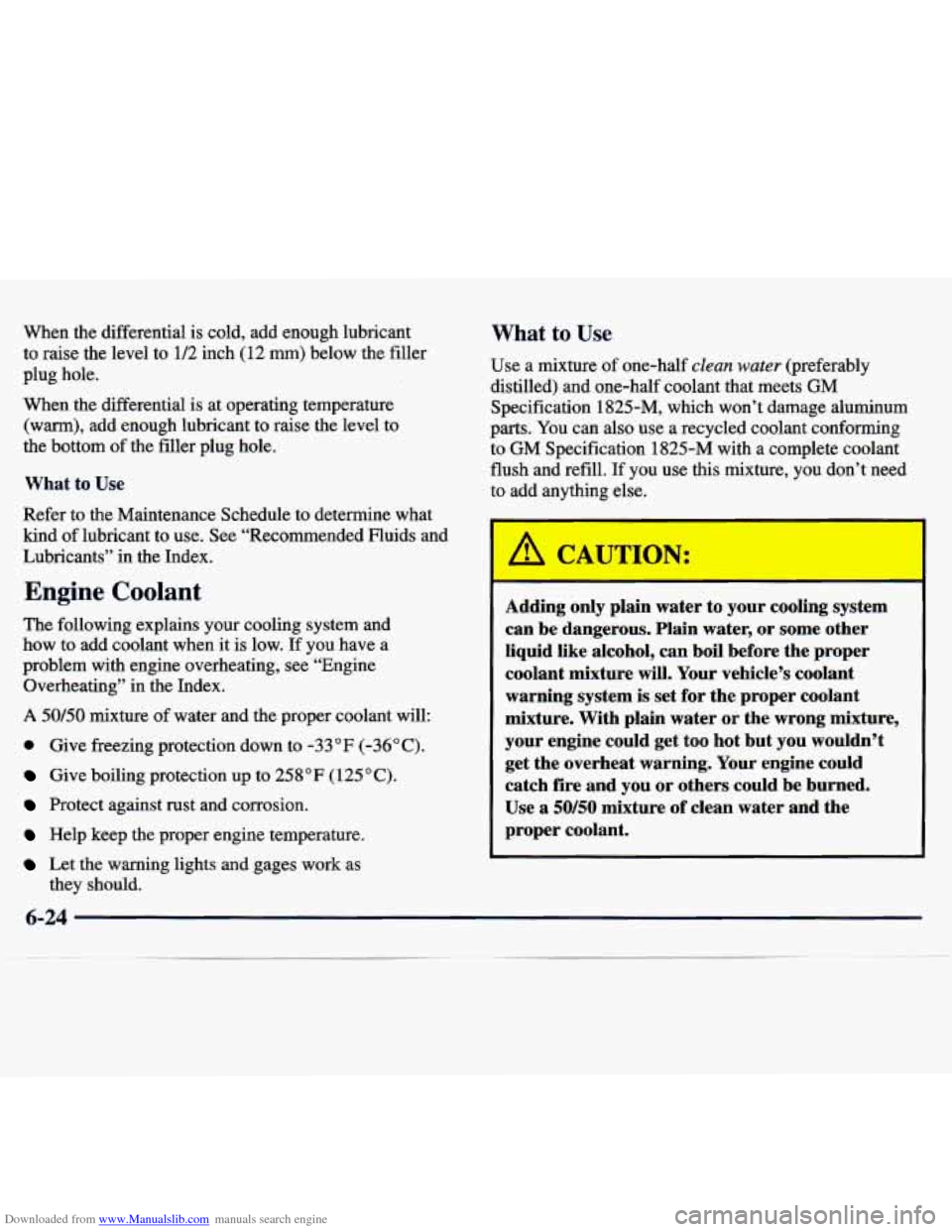
Downloaded from www.Manualslib.com manuals search engine When the differential is cold, add enough lubricant
to raise the level to 1/2 inch (12
mm) below the filler
plug hole.
When the differential is at operating temperature
(warm), add enough lubricant to raise the level to
the bottom
of the filler plug hole.
What to Use
Refer to the Maintenance Schedule to determine what
kind of lubricant to use. See “Recommended Fluids and
Lubricants” in the Index.
Engine Coolant
The following explains your cooling system and
how to add coolant when it is low. If you have a
problem with engine overheating, see “Engine
Overheating” in the Index.
A 50/50 mixture of water and the proper coolant will:
0 Give freezing protection down to -33°F (-36°C).
Give boiling protection up to 258 OF (1 25 O C).
Protect against rust and corrosion.
Help keep the proper engine temperature.
Let the warning lights and gages work as
they should.
What to Use
Use a mixture of one-half clean water (preferably
distilled) and one-half coolant that meets GM
Specification 1825-M, which won’t damage aluminum
parts.
You can also use a recycled coolant conforming
to GM Specification 1825-M with a complete coolant
flush and refill.
If you use this mixture, you don’t need
to add anything else.
Adding only plain water
to your cooling system
can be dangerous. Plain water, or some other
liquid like alcohol, can boil before the proper
coolant mixture will. Your vehicle’s coolant
warning system
is set for the proper coolant
mixture. With plain water or the wrong mixture,
your engine could get
too hot but you wouldn’t
get the overheat warning. Your engine could
catch fire and you or others could be burned.
Use a
50/50 mixture of clean water and the
proper coolant.
Page 296 of 386
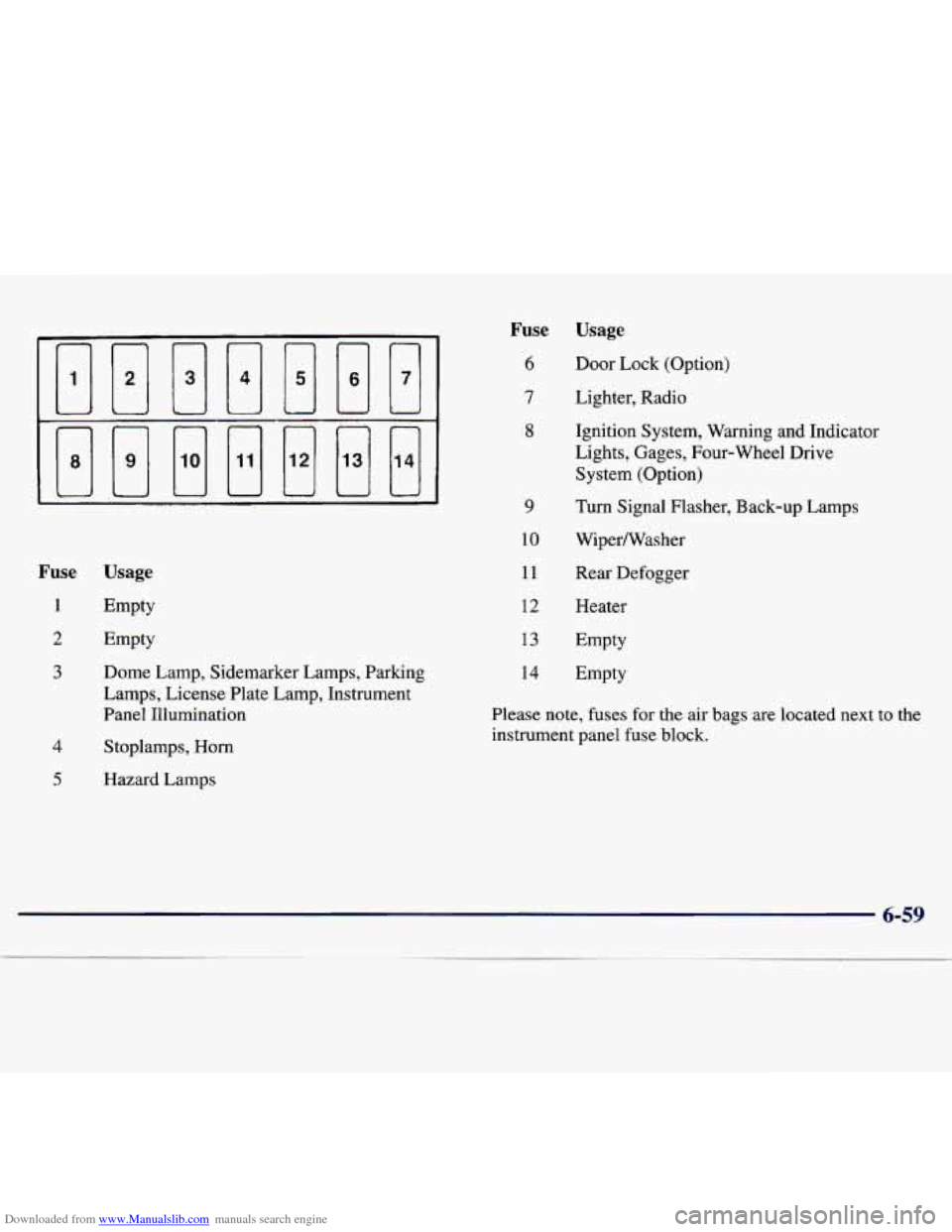
Downloaded from www.Manualslib.com manuals search engine Fuse Usage
1 Empty
2
3
4
5
Dome Lamp, Sidemarker Lamps, Parking
Lamps, License Plate Lamp, Instrument
Panel Illumination
Stoplamps,
Horn
Hazard Lamps
Fuse
6
7
8
9
10 11
12
13
14
Usage
Door Lock (Option)
Lighter, Radio
Ignition System, Warning and Indicator Lights, Gages, Four-wheel Drive
System (Option)
Turn Signal Flasher, Back-up Lamps
Wiperwasher
Rear Defogger
Heater
Empty
Empty
Please note, fuses
for the air bags are located YI IO me
instrument panel fuse block.
6-59
__
Page 379 of 386
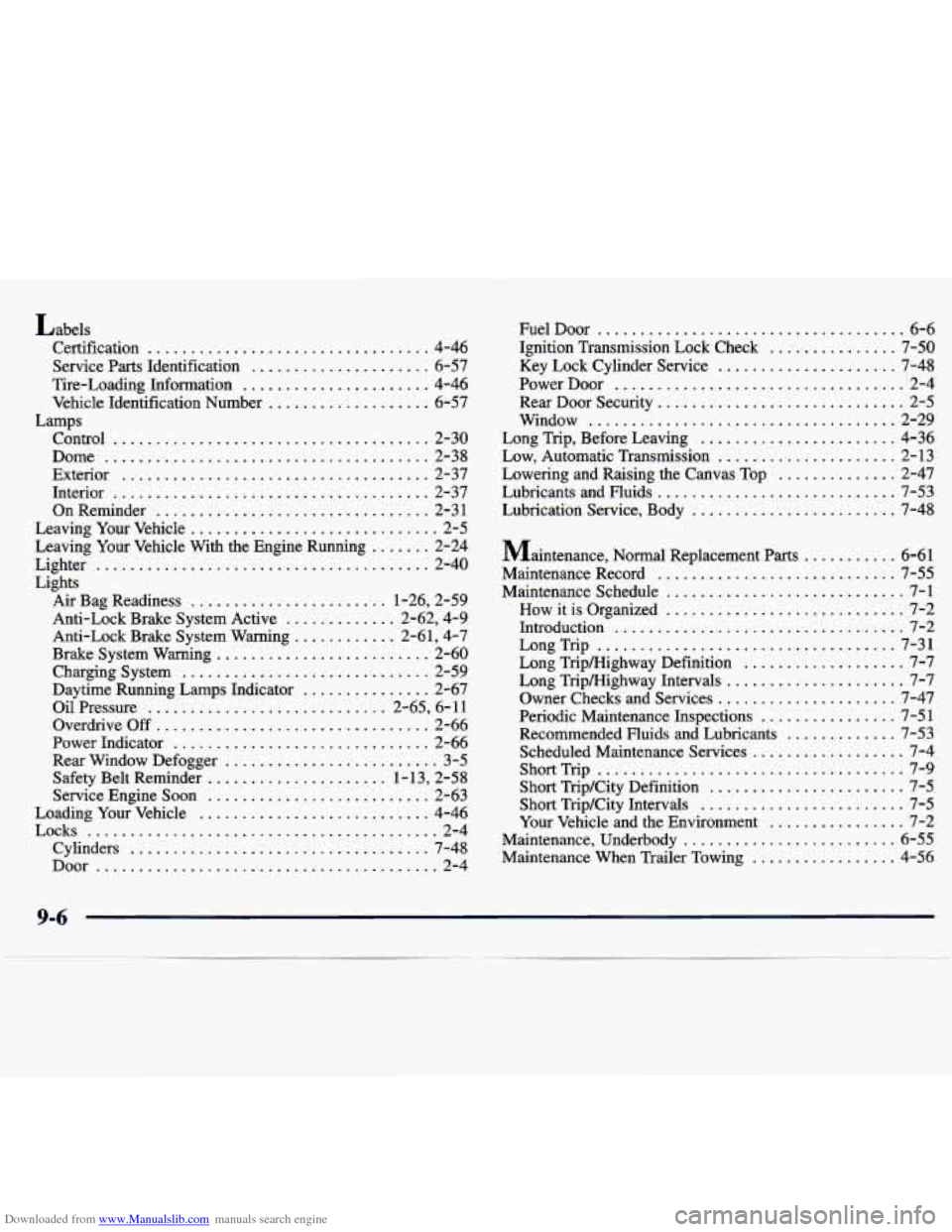
Downloaded from www.Manualslib.com manuals search engine Labels Certification
................................. 4-46
Service Parts Identification
..................... 6-57
Tire-Loading Information
...................... 4-46
Vehicle Identification Number
................... 6-57
Control
..................................... 2-30
Dome
...................................... 2-38
Exterior
.................................... 2-37
Interior
..................................... 2-37
OnReminder
................................ 2-31
Leaving Your Vehicle
............................. 2-5
Lamps
Leaving
Your Vehicle With the Engine Running
....... 2-24
Lighter
....................................... 2-40
Anti-Lock Brake System Active
............. 2.62. 4.9
Lights
Air Bag Readiness
....................... 1.26. 2.59
Anti-Lock Brake System Warning
............ 2.61. 4.7
Brake System Warning
......................... 2-60
Charging System
............................. 2-59
Daytime Running Lamps Indicator
............... 2-67
Oil Pressure
............................ 2.65. 6. 11
Overdriveoff
................................ 2-66
Power Indicator
.............................. 2-66
Rear Window Defogger
......................... 3-5
Safety Belt Reminder
..................... 1.13. 2.58
Service Engine Soon
.......................... 2-63
Loading Your Vehicle
........................... 4-46
Locks
......................................... 2-4
Cylinders
................................... 7-48
Door
........................................ 2-4 Fuel
Door .................................... 6-6
Ignition Transmission Lock Check
............... 7-50
Key Lock Cylinder Service
..................... 7-48
PowerDoor
.................................. 2-4
RearDoorSecu
rity ............................. 2-5
Window
.................................... 2-29
Long Trip, Before Leaving
....................... 4-36
Low, Automatic Transmission
..................... 2-13
Lowering and Raising the Canvas Top
.............. 2-47
Lubricants and Fluids
............................ 7-53
Lubrication Service, Body
........................ 7-48
Maintenance. Normal Replacement parts
........... 6-61
Maintenance Record
............................ 7-55
Maintenance Schedule
............................ 7-1
How it is Organized
............................ 7-2
Introduction
.................................. 7-2
LongTrip
................................... 7-31
Long Trip/Highway Intervals
..................... 7-7
Owner Checks and Services
..................... 7-47
Recommended Fluids and Lubricants
............. 7-53
Scheduled Maintenance Services
.................. 7-4
ShortTrip
.................................... 7-9
Short TripKity Definition
....................... 7-5
Short TripKity Intervals ........................ 7-5
Your Vehicle and the Environment ................ 7-2
Maintenance. Underbody
......................... 6-55
Maintenance When Trailer Towing
................. 4-56
Long
Tripmighway Definition
................... 7-7
Periodic Maintenance Inspections
................ 7-51
9-6
Page 384 of 386
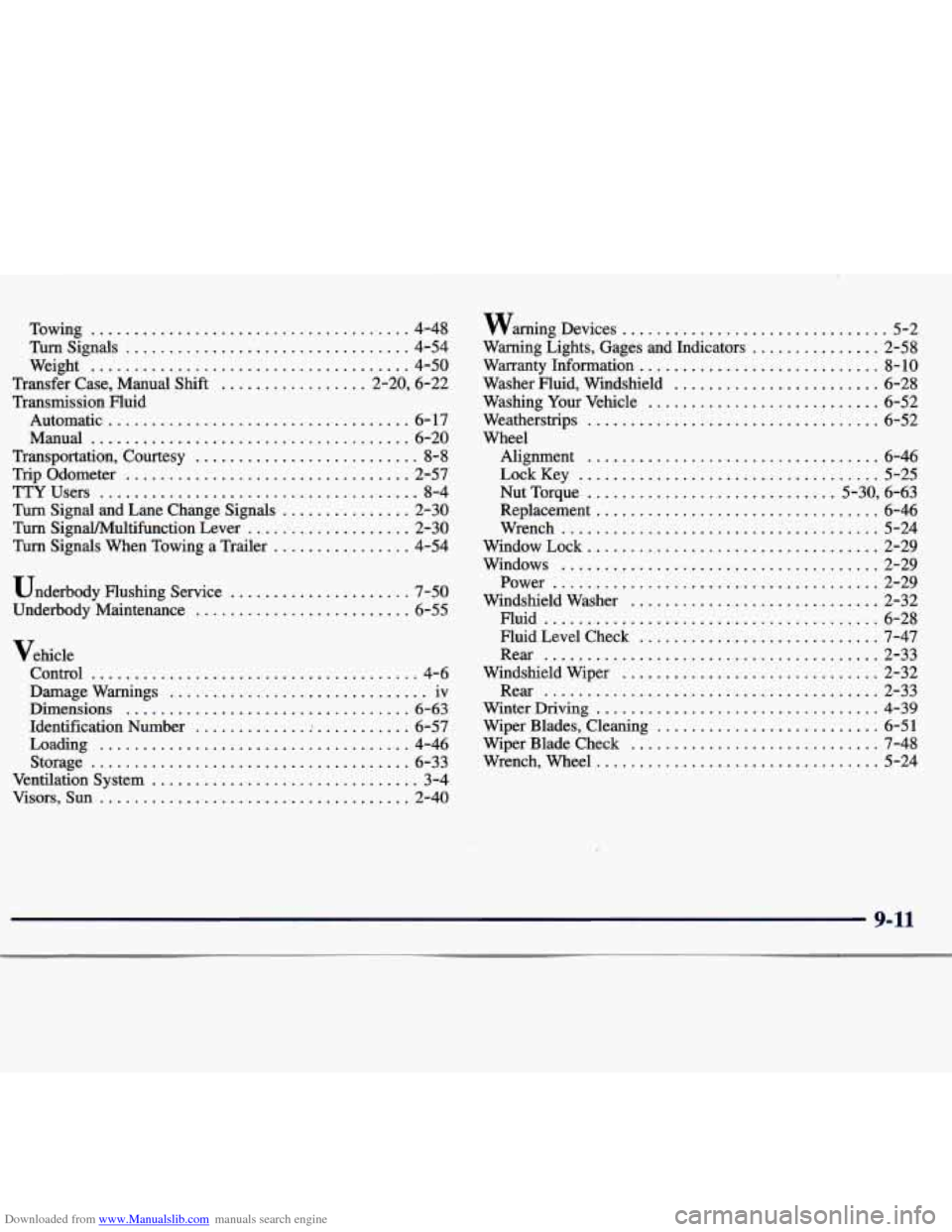
Downloaded from www.Manualslib.com manuals search engine Towing ..................................... 4-48 warning Devices ............................... 5-2
Turn Signals ................................. 4-54 Warning Lights. Gages and Indicators ............... 2-58
Weight ..................................... 4-50 WarrantyInformation ............................ 8-10
Transfer Case. Manual Shift ................. 2-20. 6-22 Washer Fluid. Windshield ........................ 6-28
Transmission Fluid Washing Your Vehicle ........................... 6-52
Automatic ................................... 6-17 Weatherstrips .................................. 6-52
Manual ..................................... 6-20 Wheel
Transportation. Courtesy
.......................... 8-8 Alignment .................................. 6-46
Trip Odometer ................................. 2-57 LockKey ................................... 5-25
TTYUsers ..................................... 8-4 Nut Torque ............................. 5.30. 6.63
Turn Signal and Lane Change Signals ............... 2-30 Replacement ................................. 6-46
Turn Signal/Multifunction Lever ................... 2-30 Wrench ..................................... 5-24
Turn Signals When Towing a Trailer ................ 4-54 Window Lock .................................. 2-29
Windows ..................................... 2-29
...................................... underbody Flushing Service 7-50
Underbody Maintenance 6-55
Power 2-29
Windshield Washer 2-32
Fluid ....................................... 6-28
..................... ............................. .........................
Vehicle
Control
...................................... 4-6
Damagewarnings .............................. iv
Dimensions
................................. 6-63
Identification Number ......................... 6-57
Loading .................................... 4-46
Storage ..................................... 6-33
Ventilation System ............................... 3-4
Visors. Sun .................................... 2-40
Fluid Level Check ............................ 7-47
Rear ....................................... 2-33
Windshield Wiper .............................. 2-32
Rear ....................................... 2-33
Winter Driving ................................. 4-39
Wiper Blades. Cleaning .......................... 6-51
WiperBladeCheck ............................. 7-48
Wrench. Wheel ................................. 5-24
9-11